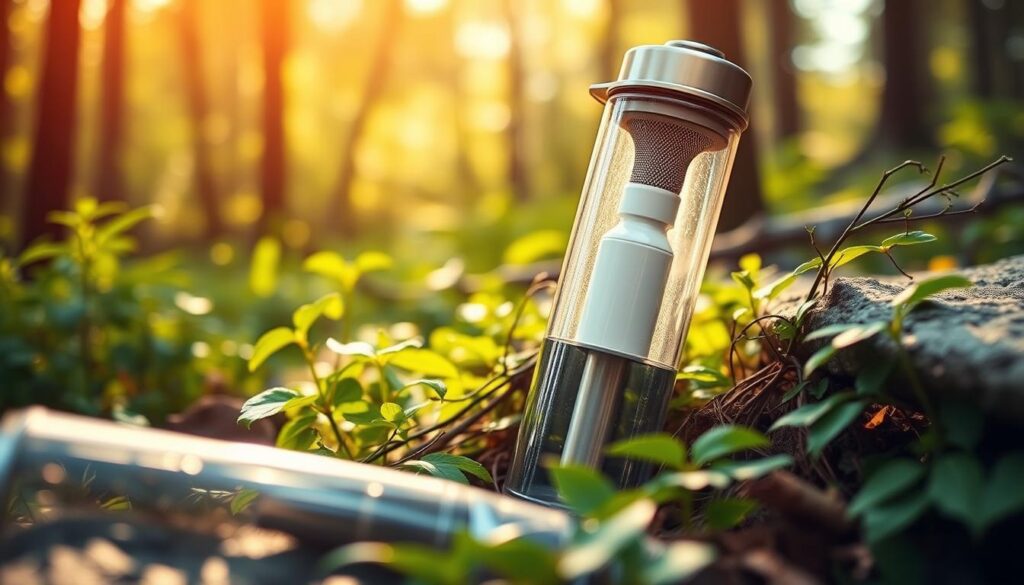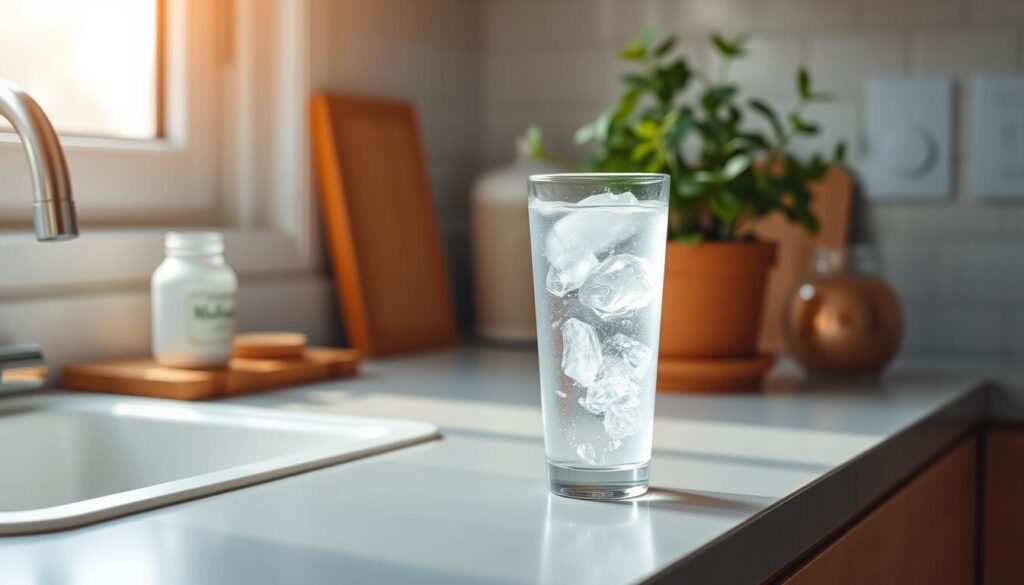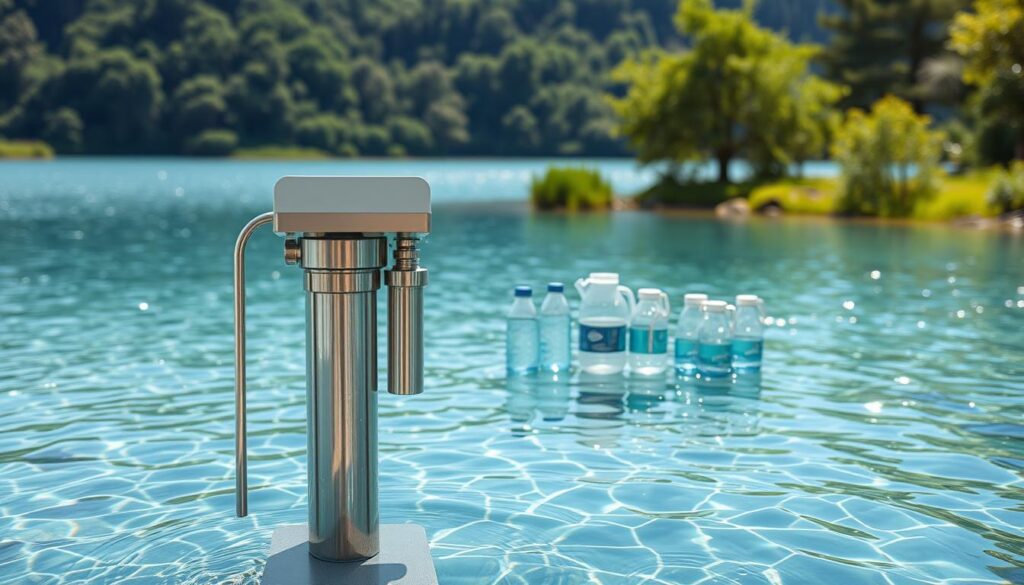When I plan a camping trip, I always make sure to have clean drinking water. It’s key for a safe and fun outdoor adventure. Having a way to purify water is essential.
Experts in outdoor adventures say clean drinking water is vital. Boiling water at 158°F (70°C) kills most harmful germs in just 1 minute. Using a portable water filter or backpacking water treatment is also a good way to keep water safe.
Key Takeaways
- Boiling water is an effective method for killing bacteria and viruses.
- Portable water filters can remove 99% of bacteria, viruses, and protozoa.
- Having access to clean drinking water is vital for a safe camping experience.
- Basic hand-operated pump filters can produce safe drinking water.
- Sophisticated portable water filters can remove various contaminants.
Understanding the Importance of Water Purification
As I get ready for my next camping trip, I remember that clean drinking water is essential. It’s not just a luxury, but a must-have for a good time outdoors. Having safe water is key to a healthy and fun camping experience.
Why Clean Water is Essential for Camping
Clean water is important for many reasons while camping. It’s needed for drinking and cooking, and also for hygiene and cleaning. Without it, campers could face serious health problems.
According to the World Health Organization, dirty water can cause diseases like diarrhea, vomiting, and fever. A study showed that waterborne pathogens are a big worry in outdoor water. Using outdoor water purification or a camping UV water purifier can help avoid these diseases.
Health Risks of Contaminated Water
Dirty water can lead to serious health issues. Some common pathogens in contaminated water include:
- Giardia and Cryptosporidium, which cause stomach problems
- Bacteria like E. coli and Salmonella, causing severe diarrhea
- Viruses such as Rotavirus and Norovirus, leading to vomiting and dehydration
Health experts say the risk of waterborne diseases is higher outdoors. This is because water sources are often untreated and can be contaminated. So, it’s important for campers to know how to purify water effectively.
“The importance of having access to clean drinking water cannot be overstated, especialy in outdoor environments where the risk of water contamination is high.”
Different Methods of Water Purification
Having a reliable way to purify water is key for a safe camping trip. In the wilderness, water can have harmful pathogens like bacteria, viruses, and protozoa.
Boiling Water: A Time-Tested Solution
Boiling water is simple and effective. Boiling it for 1-3 minutes kills most pathogens, making it safe. This method is great when other options are not available.
Water Filters: Options and Types
Water filters are another good choice. There are many types, including portable water filters that remove contaminants. When picking a filter for camping, think about the filter size, how fast it works, and how easy it is to maintain.
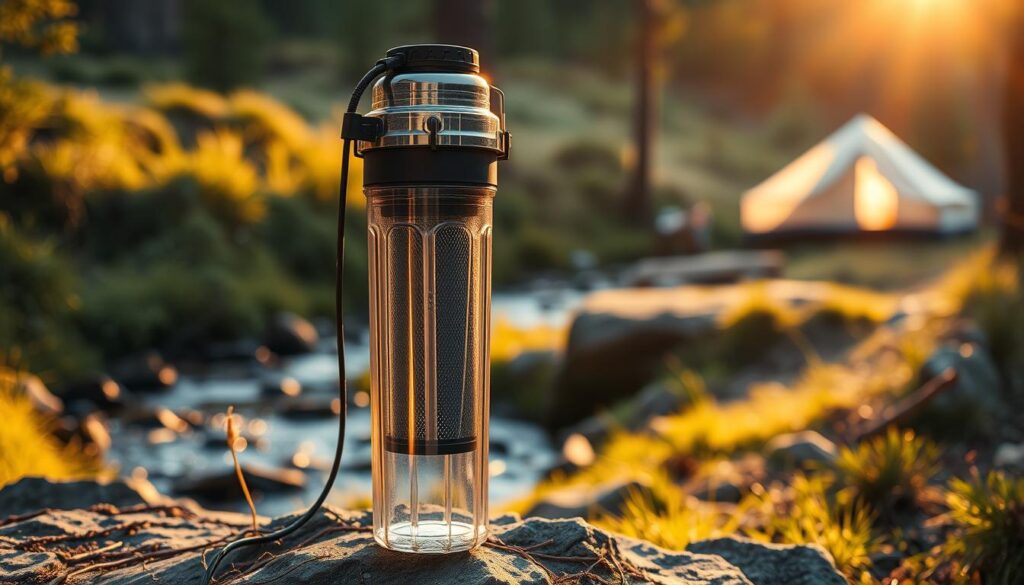
Chemical Treatments: Using Tablets and Drops
Chemical treatments, like water purification tablets or drops, are lightweight and easy to use. They contain disinfectants like chlorine or iodine that kill pathogens. Always follow the instructions for the right amount and time to use.
Here’s a comparison of the different methods:
| Method | Effectiveness | Ease of Use | Weight and Portability |
|---|---|---|---|
| Boiling | High | Moderate | Requires Fuel, Moderate |
| Water Filters | High | Easy to Moderate | Varies, Can be Lightweight |
| Chemical Treatments | High | Easy | Very Lightweight |
Choosing the Right Water Purification Method for My Needs
When I get ready for outdoor adventures, I think about what water purification method to use. It’s not easy because it depends on many things. These include where I’ll camp, the water sources, and what I like.
Factors to Consider for My Camping Trip
I look at a few key things when picking a water purification method. First, I check the water quality where I’ll be. If the water might have harmful stuff like bacteria or viruses, I need a way to get rid of it.
Another important thing is how lightweight and portable the equipment is. As a backpacker, I want something that’s easy to carry without weighing me down.
I also think about how easy it is to use and maintain. Some methods, like boiling water, are simple but take a lot of time. Others, like using filters or chemical treatments, are faster but might need more upkeep.
“The key to safe drinking water is choosing a purification method that balances effectiveness with practicality.”
Evaluating Water Sources and Quality
Before picking a purification method, I check out the water sources I’ll have. I look at how close they are to things that could make the water dirty, like farms or people.
I also check how the water looks, smells, and tastes. These signs aren’t always perfect, but they can give clues about what’s in the water.
- Look for any visible dirt or algae.
- Use kits to test for harmful stuff like bacteria or viruses.
- Think about the area’s geology, which can affect the water’s quality.
By looking at these things and thinking about my trip’s specific needs, I can pick the best water purification method. This way, I’ll have safe drinking water.
Popular Water Purification Brands
The great outdoors needs great preparation, and water purification is key. Brands like Katadyn, Sawyer, and LifeStraw are leaders. It’s important to pick a brand you can trust.
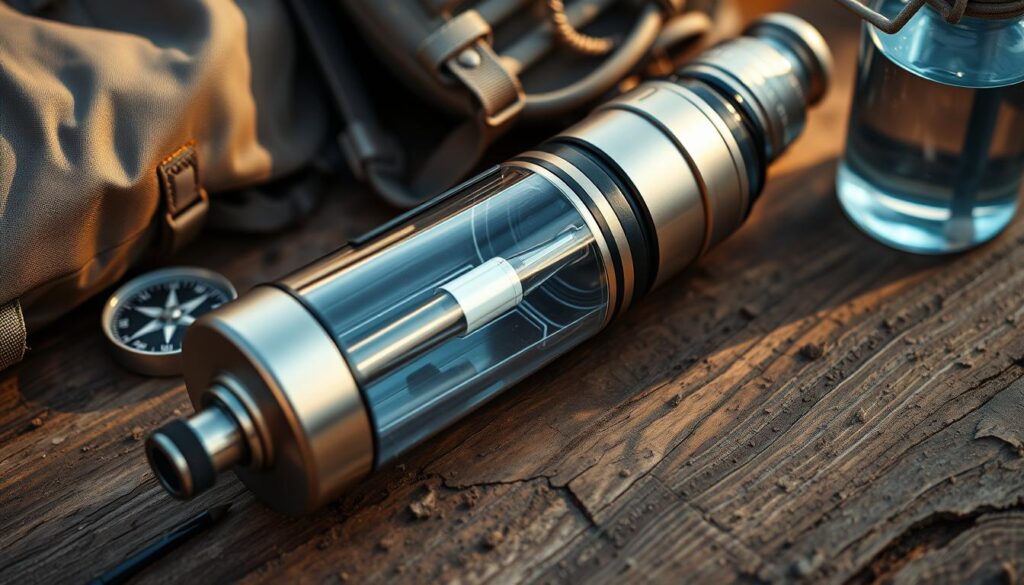
Katadyn: A Trusted Name in the Industry
Katadyn is a top name in water purification. They make high-quality filters that work well against many contaminants. Their products are durable and perfect for outdoor use.
Sawyer: Versatile and Lightweight Options
Sawyer is popular for its easy-to-use and lightweight filters. They’re great for backpackers and campers who want something convenient. Sawyer’s filters work well in different water conditions.
LifeStraw: Innovative Portable Solutions
LifeStraw is known for its portable and effective water solutions. Their products are easy to use and good for the environment. LifeStraw focuses on making functional and eco-friendly products.
Choosing the right best camping water purifier or portable water filter is important. Katadyn, Sawyer, and LifeStraw offer many effective options. Think about what you need for your trip.
How to Use a Portable Water Filter
For campers, a portable water filter is a simple and effective way to purify water from various sources. When I head out on a camping trip, I always make sure to bring one along.
Step-by-Step Instructions
Using a portable water filter involves a few straightforward steps:
- Attach the filter to a water source or a container holding the water you want to purify.
- Follow the manufacturer’s instructions to initiate the filtration process.
- Collect the filtered water in a clean container.
It’s essential to follow the manufacturer’s guidelines for the specific model you’re using, as different filters may have unique requirements.
Maintenance Tips for Longevity
Proper maintenance is key for your portable water filter’s longevity. Here are some tips to keep it in good working condition:
- Regularly clean the filter according to the manufacturer’s instructions.
- Replace filter cartridges as recommended to maintain effectiveness.
- Store the filter in a dry, protected area when not in use.
| Maintenance Task | Frequency | Importance |
|---|---|---|
| Cleaning the Filter | After Each Use | High |
| Replacing Cartridges | As Recommended | High |
| Storage Inspection | Before Each Use | Medium |
By following these steps and maintenance tips, you can ensure that your portable water filter remains a reliable tool for accessing clean drinking water during your camping adventures.
Chemical Purification: How and When to Use
As a camper, I’ve learned that chemical purification is key for clean drinking water. In the wilderness, I use chemical treatments to make water safe.
Chemical treatments, like water purification tablets and drops, fight off many pathogens. They’re great when boiling water isn’t possible or when you don’t have a water filter.
Overview of Treatment Tablets and Drops
Water purification tablets and drops have disinfectants like chlorine or iodine. They kill bacteria, viruses, and other microorganisms. The choice between tablets and drops depends on what you prefer and your camping needs.
- Tablets are easy to use with clear dosage instructions.
- Drops let you adjust the amount for different water volumes.
Dosage Guidelines for Efficiency
Following the manufacturer’s dosage guidelines is important. Wrong dosage can cause health problems or bad taste.
- Always read the instructions with the chemical treatment product.
- Change the dosage based on the water volume.
- Let the disinfectant work for the recommended time to kill pathogens.
By following these steps and using chemical treatments right, campers can have safe drinking water on their trip.
The Role of UV Light in Water Purification
UV light technology has changed how we purify water when camping. It’s key to have clean drinking water, and UV light is a reliable way to get it.
UV purifiers kill pathogens like bacteria, viruses, and protozoa with UV light. This makes the water safe to drink. It’s great because it doesn’t add chemicals, keeping the water’s taste and quality.
How UV Purifiers Work
UV purifiers are easy to use and work well. To purify water, just put the device in the water and turn it on. It takes just a few minutes to purify a liter of water.
- Submerge the UV purifier in the water.
- Activate the device to emit UV light.
- Wait for the recommended time to allow the UV light to disinfect the water.
It’s important to follow the instructions from the maker to make sure it works right.
Benefits and Limitations of UV Light
UV light is good for purifying water because it kills many pathogens and is easy to use. But, there are some downsides to think about.
Benefits:
- Effective against bacteria, viruses, and protozoa.
- No chemicals are added to the water.
- User-friendly and relatively quick.
Limitations:
- May not work against all contaminants, like heavy metals or sediment.
- Needs a power source, usually batteries.
- Must be kept in good condition to work well.
Knowing these points helps pick the best way to purify water for camping.
My Personal Experiences with Water Purification
While camping, I learned how vital water purification is. I faced many challenges that showed me clean water is key.
Challenges Faced and Lessons Learned
On a backpacking trip in a remote area, I had to use a portable water filter. It was a lesson in the right backpacking water treatment method.
Once, I used chemical treatments when I ran out of filter cartridges. I used water purification tablets and they worked well.
| Method | Effectiveness | Convenience |
|---|---|---|
| Boiling | High | Low |
| Portable Filters | High | High |
| Chemical Treatments | Medium | High |
Success Stories from My Camping Trips
I’ve had many successes with water purification on my camping trips. One trip used both portable filters and chemical treatments. It showed the importance of camping water purification.
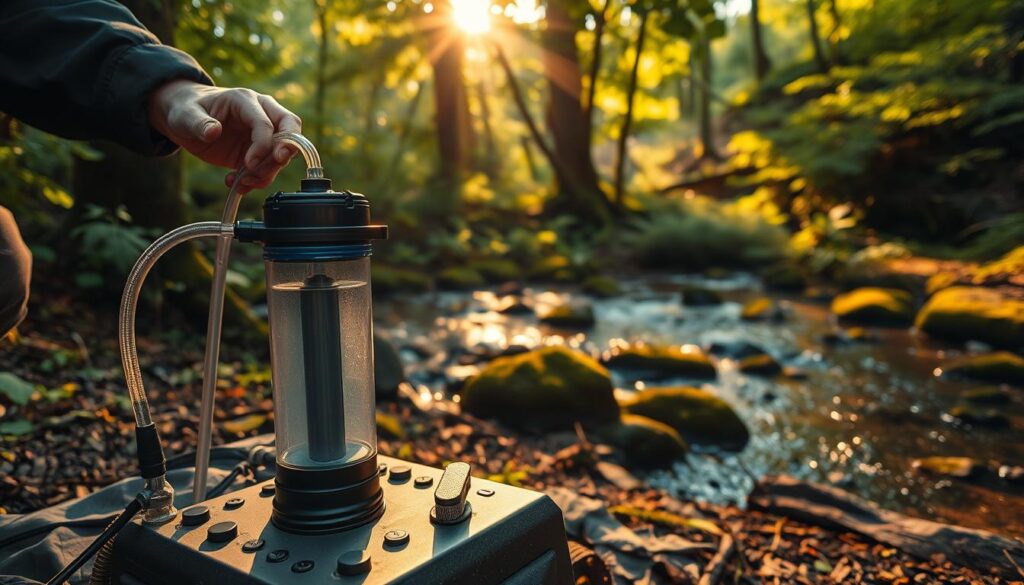
This experience taught me the need for the right equipment and knowledge. It’s essential for different situations.
Environmental Considerations in Water Purification
Water purification is key when camping. The right methods can lessen our environmental impact.
Preparing for camping, I learned water purification’s environmental impact. Luckily, there are ways to lessen this effect.
Reducing Plastic Waste with Reusable Solutions
Choosing reusable water purification is a simple way to cut down plastic waste. I avoid single-use plastic bottles and tablets. Instead, I use a portable water filter.
These filters cut down on waste and save money over time. Brands like Sawyer and LifeStraw offer durable, lightweight options. They’re perfect for eco-friendly campers.
Eco-Friendly Practices While Camping
There are more eco-friendly practices for camping. I always dispose of waste properly and keep away from natural water sources. This prevents contamination.
Using biodegradable soap and reducing campfire impact also help. These actions let us enjoy nature while keeping it safe for others.
Being aware of our actions and choosing sustainable options greatly reduces camping’s environmental impact.
Cost Considerations for Water Purification Gear
When picking the best water purification for camping, cost matters a lot. The prices of water purification gear vary a lot. You can find affordable options or high-end products with extra features.
Looking at the cost of water purification gear, think about both the start-up cost and the long-term benefits. Budget-friendly options might seem cheap at first. But they might not work as well or last as long as more expensive ones.
Budget-Friendly vs. Premium Options
For occasional use, basic water filters or chemical tablets can be a good choice. A simple water filter might cost between $20 to $50. But, advanced systems or UV purifiers can cost $100 to $300 or more.
Choosing between cheap and expensive options depends on a few things. How often you use it, how many people need clean water, and what you prefer in terms of ease and technology.
| Product Type | Cost Range | Long-Term Value |
|---|---|---|
| Basic Water Filters | $20-$50 | Good for occasional use |
| Chemical Treatment Tablets | $10-$30 | Limited by quantity needed |
| Advanced Water Filtration Systems | $100-$300 | High for frequent use |
| UV Purifiers | $50-$200 | Excellent for tech-savvy campers |
Evaluating Long-Term Value
When looking at the long-term value of water purification gear, think about the cost over time. A more expensive filter might be cheaper in the long run if it saves on replacement costs.
Long-term value also depends on how long the product lasts and the support from the maker. A product that lasts longer and has good customer service can be worth the extra cost.
In summary, while the initial cost is important, don’t forget to look at the long-term benefits and value of your choice.
Preparing for Clean Water on a Multi-Day Trip
For campers, getting clean water on a multi-day trip is key. It’s about knowing how much water we need and how to collect it efficiently.
Planning Water Needs for My Group
I think about a few things when planning water needs. These include how many people are in my group, how long we’ll be camping, and what we’ll do. A person needs 2-3 liters of water per day for drinking, cooking, and staying clean.
To figure out how much water we’ll need, I multiply the number of people by the number of days. Then, I multiply that by the daily water need per person. This tells me how much water we’ll need, helping me plan how to collect and purify it.
Strategies for Efficient Water Collection
Finding water efficiently is important on a multi-day trip. I look for multiple water sources like streams, rivers, or ponds. I also check the water quality and plan how to purify it.
Using a portable water filter or purification tablets is another good idea. These let us get water from different places and clean it right away. This way, we don’t have to rely on just one water source.
I also try to use less water by saving it for drinking and essential uses. This helps us make our water last longer. It ensures we have enough clean water for drinking during our trip.
By planning our water needs and using smart ways to collect it, we can stay hydrated and healthy on our multi-day camping trip.
Resources for Further Information on Water Purification
Exploring camping and water purification is exciting. It’s important to have reliable resources for more information. Whether you’re experienced or new, knowing the right stuff is key for a safe and fun trip.
Recommended Guides
Many guides offer detailed info on water purification and camping. They talk about water filters, chemical treatments, and UV light purification. Brands like Katadyn and Sawyer have great resources on their products and how to use them.
Online Forums for Camping Enthuasiasts
Online communities are great for sharing camping knowledge. They have discussions on water purification, where people share their experiences. This is a good place to find out about the best methods and products.
FAQ
What is the most effective method for purifying drinking water while camping?
The best method depends on the water quality and what you prefer. Boiling, using a portable filter, or chemical treatments work well.
How do I choose the best camping water purifier for my needs?
Think about the water quality, where you’ll camp, and what you like. Knowing the water source is key to picking the right method.
What are the benefits of using a portable water filter for camping?
Portable filters, like those from Katadyn, Sawyer, and LifeStraw, remove contaminants. They’re also light and easy to use.
How do I properly maintain my portable water filter?
Clean and replace the filter cartridges as needed. This keeps the filter working well.
Can I use chemical treatments, such as water purification tablets, to disinfect water?
Yes, chemical treatments can disinfect water. Just make sure to follow the instructions for best results.
How does UV light purify water, and what are its limitations?
UV purifiers kill pathogens with UV light. But, they might not remove all contaminants, like particles or chemicals.
What are some eco-friendly practices I can adopt while camping to reduce my environmental impact?
Use less plastic and choose reusable items, like refillable water bottles. This helps protect the environment.
How do I plan for clean drinking water on a multi-day camping trip?
Plan your water needs and pack the right gear, like a portable filter or tablets. This ensures clean water all trip long.
What are some budget-friendly options for water purification gear?
Affordable choices include tablets or basic filters. But, premium options might be worth it for better quality.
Where can I find more information on water purification and camping?
Check out books, guides, and online forums. They offer great advice and connect you with other campers.
What are some common mistakes to avoid when purifying drinking water while camping?
Don’t neglect your gear, ignore instructions, or overlook water quality. These mistakes can be harmful.
Can I use a lightweight water purifier for backpacking?
Yes, many filters, like Sawyer’s, are made for backpacking. They’re light and compact.
How do I know if my water purification method is effective against all contaminants?
Choose a method that tackles a wide range of contaminants. This includes bacteria, viruses, and parasites.

